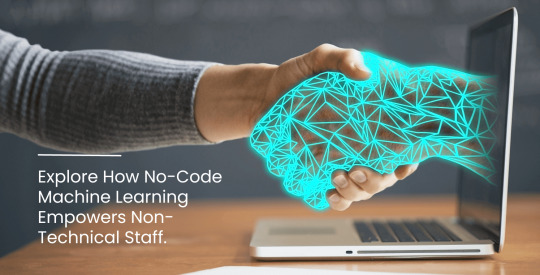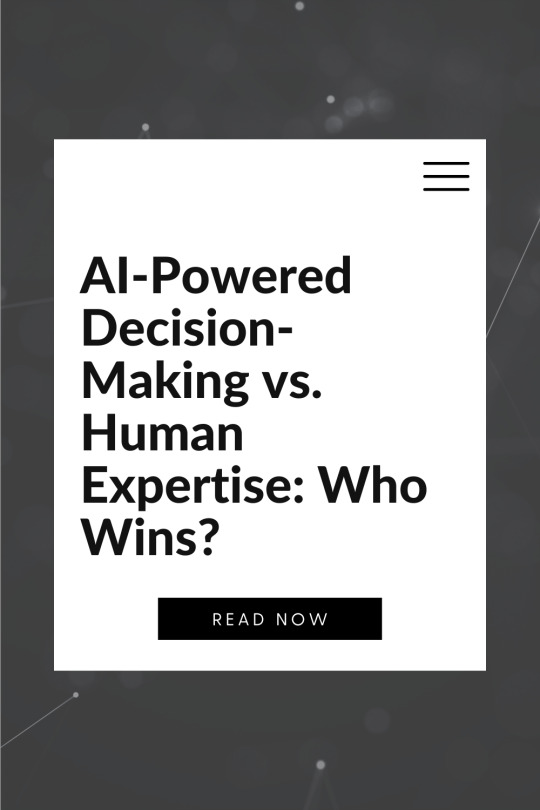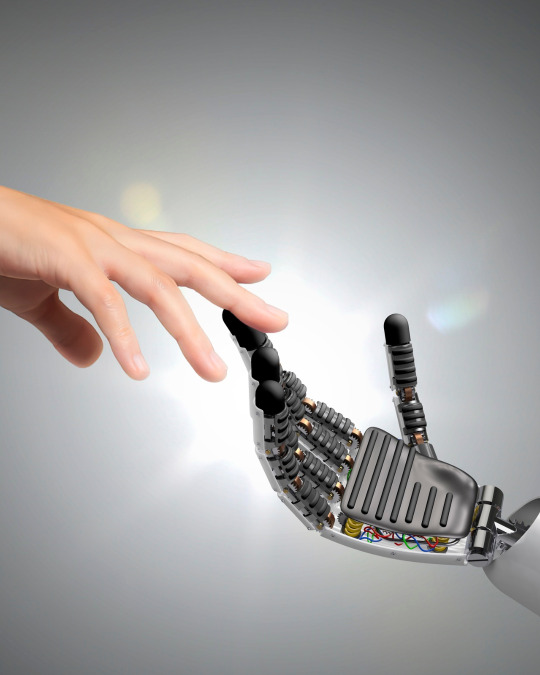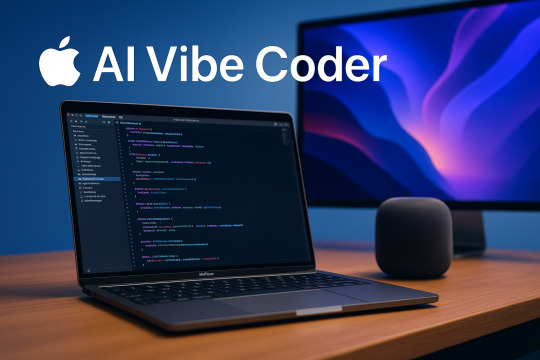#no code machine learning tools
Explore tagged Tumblr posts
Text

Discover how no code machine learning is revolutionizing the way non technical staff can harness the power of AI. This guide will walk you through the basics!
#no code ml#no code machine learning#no code machine learning tools#machine learning no code#no code ml platforms
0 notes
Text
Top 5 Benefits of Low-Code/No-Code BI Solutions
Low-code/no-code Business Intelligence (BI) solutions offer a paradigm shift in analytics, providing organizations with five key benefits. Firstly, rapid development and deployment empower businesses to swiftly adapt to changing needs. Secondly, these solutions enhance collaboration by enabling non-technical users to contribute to BI processes. Thirdly, cost-effectiveness arises from reduced reliance on IT resources and streamlined development cycles. Fourthly, accessibility improves as these platforms democratize data insights, making BI available to a broader audience. Lastly, agility is heightened, allowing organizations to respond promptly to market dynamics. Low-code/no-code BI solutions thus deliver efficiency, collaboration, cost savings, accessibility, and agility in the analytics landscape.
#newfangled#polusai#etl#nlp#data democratization#business data#big data#ai to generate dashboard#business dashboard#bi report#generativeai#business intelligence tool#artificialintelligence#machine learning#no code#data analytics#data visualization#zero coding
3 notes
·
View notes
Text

AI-Powered Decision-Making vs. Human Expertise: Who Wins?
Artificial intelligence is already woven into the fabric of our daily lives. Whether you're getting personalized song suggestions on Spotify, seeing curated content on Netflix, navigating traffic with Google Maps, or having your email sorted by importance in Gmail, AI is quietly and powerfully shaping the choices we make. These AI-driven tools are making decisions on our behalf every day, often without us even realizing it.
As AI continues to evolve, its role is expanding from recommending entertainment to influencing high-stakes decisions in healthcare, finance, law enforcement, and beyond. This growing presence raises a critical question: Can AI truly make better decisions than experienced human professionals or does it still fall short in areas where human judgment and intuition reign supreme?

Understanding the Players: AI and Human Experts
What Is AI-Powered Decision-Making?
AI-powered decision-making refers to the use of algorithms, often driven by machine learning, neural networks, and deep learning, to analyze large datasets and generate insights, predictions, or recommendations. These systems can learn from experience, identify patterns humans may miss, and make decisions without fatigue or bias (at least in theory).
Key strengths include:
Speed and scale: AI can process terabytes of data in seconds.
Pattern recognition: It detects trends and anomalies better than humans in complex datasets.
Consistency: AI doesn’t suffer from emotions, distractions, or exhaustion.
What Defines Human Expertise?
Human expertise, on the other hand, is built on years, sometimes decades, of learning, intuition, and contextual understanding. An expert blends theoretical knowledge with practical experience, social awareness, and ethical judgment.
Human strengths include:
Contextual understanding: Experts can interpret ambiguous or nuanced situations.
Empathy and ethics: Humans bring emotional intelligence and moral reasoning to decisions.
Adaptability: Experts can pivot strategies in response to changing circumstances or incomplete data.
So, which is better? As with many complex questions, the answer depends on the context.
When AI Outperforms Humans
1. Data-Heavy Decisions
AI shines when the decision-making process requires analyzing vast amounts of data quickly. In fields like finance and healthcare, AI systems are revolutionizing decision-making.
Example: Medical diagnostics. AI algorithms trained on millions of medical images have demonstrated higher accuracy than radiologists in detecting certain cancers, such as breast and lung cancers. These systems can spot subtle patterns undetectable to the human eye and reduce diagnostic errors.
2. Predictive Analytics
AI’s ability to forecast outcomes based on historical data makes it incredibly powerful for strategic planning and operations.
Example: Retail and inventory management. AI can predict which products will be in demand, when restocking is necessary, and how pricing strategies will affect sales. Amazon’s supply chain and logistics systems are powered by such predictive tools, allowing for just-in-time inventory and efficient deliveries.
3. Repetitive, Rule-Based Tasks
AI thrives in environments where rules are clear and outcomes can be mathematically modelled.
Example: Autonomous vehicles. While not perfect, AI is capable of processing sensor data, mapping environments, and making real-time navigation decisions; tasks that are highly rule-based and repetitive.
Where Human Expertise Wins
1. Complex, Ambiguous Situations
Humans excel in “grey areas” where rules are unclear, data is incomplete, and judgment calls must be made.
Example: Crisis management. In rapidly evolving scenarios like natural disasters or geopolitical conflicts, experienced human leaders are better at weighing intangible factors such as public sentiment, cultural nuances, and ethical trade-offs.
2. Empathy and Human Interaction
Some decisions require understanding human emotions, motivations, and relationships which are areas where AI still lags significantly.
Example: Therapy and counselling. While AI chatbots can offer basic mental health support, human therapists offer empathy, intuition, and adaptive communication that machines cannot replicate.
3. Ethical Judgment
Ethical dilemmas often involve values, societal norms, and moral reasoning. Human decision-makers are uniquely equipped to handle such complexity.
Example: Autonomous weapons and warfare. Should an AI-powered drone have the authority to make life-or-death decisions? Most ethicists and governments agree that moral accountability should rest with humans, not algorithms.
“The goal is to create AI that can collaborate with people to solve the world’s toughest problems, not replace them.”
— Demis Hassabis (CEO and Co-founder of DeepMind)
AI vs. Human in Chess and Beyond
In 1997, IBM’s Deep Blue defeated world chess champion Garry Kasparov; a symbolic moment that marked AI’s growing capabilities. Today, AI engines like AlphaZero play chess at a superhuman level, discovering strategies that human players never imagined.
But even Kasparov himself has advocated for “centaur chess” which is a form of play where humans and AI collaborate. He argues that human intuition, combined with machine calculation, makes for the most powerful chess strategy.
This concept extends beyond the game board. In many domains, the ideal approach may not be AI versus humans, but AI with humans.
Toward a Collaborative Future: The Human-AI Team
Rather than replacing humans, the most promising applications of AI lie in augmenting human decision-making. This “centaur model” or “human-in-the-loop” approach brings out the best in both.
Examples of Human-AI Collaboration:
Healthcare: AI can screen X-rays, while doctors make the final diagnosis and communicate with patients.
Recruitment: AI can sort resumes and highlight top candidates, but human recruiters assess cultural fit and conduct interviews.
Customer service: AI chatbots handle routine queries, while complex issues are escalated to human agents.
This hybrid approach ensures accuracy, empathy, and accountability, all while improving efficiency.
Challenges & Considerations
Even as we embrace AI, several challenges must be addressed:
Bias in AI: If the data AI learns from is biased, its decisions will be too. Human oversight is essential to ensure fairness and ethical outcomes.
Transparency: Many AI systems are “black boxes,” making it hard to understand how decisions are made.
Accountability: Who is responsible when an AI system makes a wrong call? Legal and regulatory frameworks are still catching up.
Job displacement: As AI takes over certain tasks, reskilling and transitioning the workforce become critical priorities.
Final Verdict: Who Wins?
The battle between AI and human expertise doesn’t have a single winner because it's not a zero-sum game. AI wins in data-heavy, rules-based, and high-speed environments. Humans excel in judgment, empathy, and moral reasoning. The true power lies in collaboration.
As we move into the next phase of digital transformation, the organizations and societies that will thrive are those that leverage both machine precision and human wisdom. In this partnership, AI isn’t replacing us, it’s empowering us.
So the real question isn’t "who wins?" it’s "how do we win together?"
Learn more about DataPeak:
#datapeak#factr#saas#technology#agentic ai#artificial intelligence#machine learning#ai#ai-driven business solutions#machine learning for workflow#ai solutions for data driven decision making#ai business tools#aiinnovation#digitaltools#digital technology#digital trends#dataanalytics#data driven decision making#data analytics#ai platform for business process automation#ai driven business solutions#ai business solutions#business#cloudmigration#cloudcomputing#no code
0 notes
Text
Apple AI Vibe Coder
#AI Vibe#Apple AI#Anthropic Claude#AI coding assistant#AI for developers#Xcode AI#Swift Playgrounds#AI programming tools#Claude 3#Apple developer tools#Generative AI coding#AI-powered IDE#Machine learning coding assistant#Code automation#Software development AI#ai latest update#artificial intelligence#ai news
1 note
·
View note
Text
today i finally clocked how much coursework i actually have to do and yknow what it may actually be over
#music is 60% coursework(3 compositions 2 performances)#then 20% nea for electronics which sounds alright but its makin 2 whole ass systems from scratch#which. the one worth less marks *requires* me to program a chip using assembly language FUCK OFF!!!#with documentation too. idk what documentation means here but it scares me#and then computer science. also 20%. programming project with documentation do whatever the fuck u want as long as its up to standard#dude we looked at some example/past nea documentations. its like. my teacher literally said its like doing a dissertation#he brought out past ones and they were like wads of 100+ pages of nothing but code and graphs and testing and analysis and#all the programs themselves too were like. gravity simulator. machine learning teaching tool. what#what the fuck am i going to do#for any of this#it may be over. maybe
0 notes
Text
AI Assistants: Revolutionary Tech or Just Fancy Autocomplete?
If you’ve spent any time on tech Twitter (or anywhere that developers complain about their jobs), you’ve probably seen the buzz around AI-powered coding assistants like GitHub Copilot. The hype suggests that AI is revolutionizing programming, making developers obsolete, and possibly achieving sentience by next Tuesday. But let’s take a deep breath—most of this excitement is actually about machine…
#ai#Automation#Chatbot#Chatbot Builder#Coding#Finance#Machine Learning#Millennials#Productivity Tools#TechTrend
0 notes
Text
Emly Labs
Emly Labs Offers a Comprehensive No-Code AI Solution Builder That Empowers Users of Non-Technical Fields to Harness the Full Potential of Generative and Predictive AI.
#ai#ai generated#artificial intelligence#coding#machine learning#programming#amp#chatbots#chatgpt#ai bots#ai tools
1 note
·
View note
Text
Exploring the Latest Trends in Software Development
Introduction The software is something like an industry whose development is ever-evolving with new technologies and changing market needs as the drivers. To this end, developers must keep abreast with current trends in their fields of operation to remain competitive and relevant. Read to continue .....
#analysis#science updates#tech news#technology#trends#adobe cloud#business tech#nvidia drive#science#tech trends#Software Solutions#Tags5G technology impact on software#Agile methodologies in software#AI in software development#AR and VR in development#blockchain technology in software#cloud-native development benefits#cybersecurity trends 2024#DevOps and CI/CD tools#emerging technologies in software development#future of software development#IoT and edge computing applications#latest software development trends#low-code development platforms#machine learning for developers#no-code development tools#popular programming languages#quantum computing in software#software development best practices#software development tools
0 notes
Text
A Beginner's Guide to AI Art with Open-Source Tools
Artificial Intelligence (AI) has transcended its conventional applications and found a new canvas in the realm of art, igniting a wave of creativity that blurs the lines between human and machine-generated artworks. As technology advances, AI art has emerged as a captivating fusion of algorithms, data, and human ingenuity, captivating audiences and creators alike with its mesmerizing…

View On WordPress
#ai art#AI art tools#ai creativity#ai generator#ai image#Algorithmic Art#art inspiration#Computational Creativity#Creative coding#creative technology#Deep Learning#Digital Creativity#Machine Learning#neural networks#neural style transfer#open source tools
0 notes
Text
Discover the incredible potential of AI and machine learning without any coding skills required. NextBrain offers a user-friendly platform for no code machine learning. Start unleashing the power of AI today!
#no code ml#no code machine learning#no code machine learning tools#machine learning no code#no code ml platforms
0 notes
Text
What advantages does PolusAI provide in terms of speed and decision-making? PolusAI accelerates data analytics processes, offering nine times faster generation of dashboards and insights, enabling swift data-driven decision-making. This rapid processing allows businesses to act on insights five times faster than traditional methods, enhancing responsiveness and strategic agility. PolusAI’s homegrown NLP engine provides real-time insights, ensuring decision-makers have up-to-date information. By streamlining data analysis and reducing the time from data collection to actionable insights, PolusAI significantly improves operational efficiency and decision accuracy, helping businesses maintain a competitive edge and quickly adapt to market changes.
#newfangled#polusai#etl#nlp#data democratization#business data#big data#ai to generate dashboard#business dashboard#bi report#generativeai#business intelligence tool#artificialintelligence#machine learning#no code#data analytics#data visualization#zero coding
0 notes
Text

Why Traditional Automation Can’t Keep Up With Data Complexity
Automation has been a cornerstone of business efficiency, helping organizations streamline workflows, minimize human error, and accelerate processes. However, the landscape of data operations has evolved dramatically. Businesses today are grappling with an unprecedented surge in data—both in sheer volume and in its complexity. Traditional automation, once a reliable solution, is now struggling to keep pace with modern demands.
With data coming in at higher velocities and in increasingly unstructured forms, static automation methods are no longer enough. Organizations need systems that can adapt in real time, analyze complex relationships, and seamlessly integrate across platforms. This is where AI-driven automation steps in. In this blog, we’ll explore the pitfalls of traditional automation, the challenges posed by modern data landscapes, and why no-code, AI-powered automation is the future of data operations.
The Pitfalls of Legacy Workflows
Traditional automation was built for a simpler time when data was structured, predictable, and relatively static. It relied heavily on rule-based systems, rigid workflows, and development-intensive implementations like Robotic Process Automation (RPA) and hard-coded scripts. While these approaches worked well in environments with low variability, they are increasingly struggling to keep up with today’s dynamic data ecosystem.
Why Traditional Automation Falls Short
Rules-Based and Brittle: Legacy automation follows pre-set rules that lack adaptability, making it difficult to accommodate new variables without extensive reconfiguration. As business needs evolve, traditional automation requires constant manual updates, leading to inefficiencies and delays.
Development-Heavy: Many traditional automation workflows require significant developer resources, leading to higher maintenance costs and longer deployment cycles. This creates bottlenecks, as organizations must constantly rely on technical teams to make even minor modifications.
Lack of Real-Time Adaptability: In a world where data is constantly changing, rigid workflows fail to process information efficiently and in real-time. This inability to adjust quickly can result in missed opportunities, inaccurate insights, and outdated decision-making processes.

The New Challenges: Evolving Data Landscape
Today's data operations face an unprecedented level of complexity. The increase in data volume, velocity, and variety has rendered static automation ineffective. Organizations now deal with:
Messy and Unstructured Data: Traditional workflows struggle with unstructured formats like video, images, and real-time text streams. Businesses must process diverse data sources, but legacy systems are often limited to handling structured inputs, leaving valuable insights untapped.
Real-Time Processing Needs: Legacy systems aren't designed for streaming data or dynamic decision-making at scale. In industries like finance and cybersecurity, where split-second decisions are crucial, traditional automation simply cannot keep up.
Data Silos and Integration Issues: Legacy automation often struggles with integrating disparate data sources, leading to inefficiencies and lost insights. Without seamless interoperability between systems, organizations face data fragmentation, making it difficult to gain a holistic view of their operations.
Imagine trying to scale traditional automation amidst this chaotic and fast-moving data landscape. It would be like navigating a bustling metropolis with a horse and carriage—completely out of sync with the pace of modern operations.
“AI has the power to unlock unprecedented productivity and innovation across all industries.” — Param Kahlon, Chief Product Officer at UiPath
The Inevitable Shift to Smarter Automation
The shift from traditional automation to no-code and agentic AI solutions isn’t just an upgrade—it’s a necessity. It’s about creating systems that can evolve, adapt, and make smarter decisions in an ever-changing environment.
Why No-Code + Agentic AI Is the Future
Flexibility: AI-driven automation can adjust to changing data structures, making workflows more adaptable. Unlike rigid traditional automation, AI can refine and enhance processes automatically, reducing the need for human intervention.
Resilience: Unlike traditional automation, AI-assisted solutions improve over time by learning from data patterns and anomalies. They continuously optimize themselves, reducing error rates and improving performance.
Accessibility: No-code platforms empower non-technical users to build and modify workflows, reducing the reliance on scarce developer resources. This democratization of automation allows business users to take control of processes without waiting on IT.
Efficiency: AI-assisted automation can process vast amounts of data in real-time, unlocking faster decision-making. Organizations can reduce latency, eliminate manual errors, and ensure more accurate, data-driven insights.
Strategic Advantages of Smarter Automation
By embracing smarter automation, organizations gain several advantages that were previously out of reach:
Faster Iteration Cycles: No-code solutions allow teams to quickly test, refine, and deploy automation without heavy coding dependencies. This agility enables businesses to respond rapidly to market shifts, regulatory changes, or operational challenges.
Reduced Tech Debt: Organizations can scale without being bogged down by legacy code that requires constant upkeep. As AI-assisted automation adapts and self-improves, the need for continuous patches and fixes is significantly reduced.
Improved Decision-Making: AI-powered automation continuously refines its processes, leading to more accurate and insightful data-driven decisions. This helps businesses optimize performance, minimize risks, and seize opportunities with confidence.
Examples of Traditional Models Breaking Down
Here are some real-world scenarios where traditional automation falls short:
Financial Services: Legacy automation struggles to detect fraud patterns that evolve rapidly in response to new threats, whereas AI-driven automation continuously adapts. Traditional models rely on static rules, making them vulnerable to sophisticated fraud tactics.
Supply Chain Management: Static workflows fail to adjust to real-time disruptions like shipping delays, leading to inefficiencies and lost revenue. AI-driven automation can predict potential delays and reroute logistics accordingly, ensuring smoother operations.
Customer Support: Traditional chatbots rely on pre-programmed responses, often failing to understand nuanced customer queries, while AI-powered bots learn from interactions to improve response accuracy. This results in better customer experiences and reduced support overhead.
Embrace the Inevitable Shift
The limitations of traditional automation are no longer minor inconveniences; they are active roadblocks to efficiency and scalability. The shift towards AI-assisted, no-code automation is not optional—it’s overdue. Organizations must audit their current workflows to identify fragility and bottlenecks and take proactive steps toward modernizing their automation strategies.
Learn More About DataPeak:
#datapeak#factr#technology#agentic ai#saas#artificial intelligence#machine learning#ai#ai-driven business solutions#machine learning for workflow#ai business tools#ai solutions for data driven decision making#aiinnovation#digitaltools#digital technology#digital trends#datadrivendecisions#data driven decision making#data analytics#dataanalytics#no code
0 notes
Text

AI Vibe Coder is your go-to digital muse for all things coding and creativity. Blending AI-powered tools with a passion for sleek code and futuristic design, this blog explores the rhythm of modern development—from smart automation to aesthetic programming hacks. Follow for tech vibes, dev tips, and AI-driven inspiration.
#AI Vibe#Apple AI#Anthropic Claude#AI coding assistant#AI for developers#Xcode AI#Swift Playgrounds#AI programming tools#Claude 3#Apple developer tools#Generative AI coding#AI-powered IDE#Machine learning coding assistant#Code automation#Software development AI#ai latest update#artificial intelligence#ai news
0 notes
Text
#coding#angular#php#php programming#placements#training#laravel#php framework#php training#phpwebsitedevelopment#python#django#artificial intelligence#machine learning#technology#ai technology#ai tools#react js#reactjs
0 notes
Text
#artificial intelligence#machine learning#coding#ai art#ai artwork#ai girl#midjourney#ai tools#chatgpt#chatbots#ai technology#technology
1 note
·
View note
Text
How to Install Kali Linux in VMware in Just 4 Simple Steps (Easiest Way)
In this guide, you will be able to learn the easiest way of how to install Kali Linux on VMware in Just 4 Simple Steps, I hope this helps a lot!
To keep in mind: Obtaining unauthorized access to another’s computer system or systems is illegal under the Computer Fraud & Abuse Act. Here you will find a step by step guide on how to install Kali Linux onto VMware. The main purpose of this blog tutorial is to educate others on cyber security tools, technologies, and techniques with the intention of creating consciousness for others on better…

View On WordPress
#best cybersecurity tools#Cybersecurity#cybersecurity course#cybersecurity jobs#ethical hacking#How to#how to code#how to install#how to install kali linux#how to install vmware#how to learn cybersecurity#how to learn linux#how to use a virtual machine#Kali Linux#linux#linux jobs#virtual machine#VMware
0 notes